Climate Change Representation in Popular Movies Is Low, But It’s On the Rise and More Profitable
8 Mins Read
Only 9.6% of films over the last decade passed the Climate Reality Check, though these doubled in the latter half of this period and were more profitable, according to a new report.
Glass Onion, The Amazing Spider-Man 2, Tenet, Marriage Story and Don’t Look Up make up just a handful of movies that pass the Climate Reality Check – the “Bechdel-Wallace Test for a world on fire” – according to a new report.
Co-authored by climate story consultancy Good Energy and Colby College’s Buck Lab for Climate and Environment, the analysis looks into 250 of the most popular films between 2013 and 2022 (based on IMDb ratings). While the Bechdel Test is used as a marker for gender representation, the Climate Reality Check – unveiled just weeks earlier – explores the visibility of climate change onscreen.
Eligible movies must be set on Earth and either in the present or near future, and are assessed on two basic stipulations: climate change exists, and a character knows it. It was developed in consultation with over 200 writers, showrunners, executives and communications experts, with the goal of seeing 50% of contemporary films pass the test by 2027.
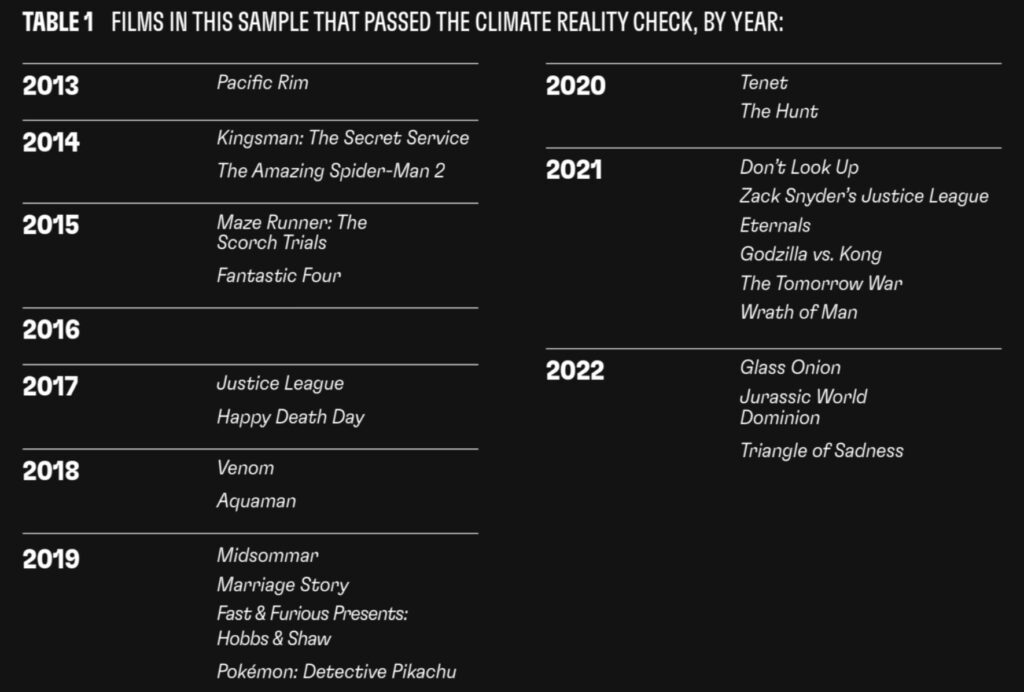
The report found that currently, only 24 movies (9.6%) do so, while climate change exists in 32 (12.8%) of the films (which passes the first part of the test). And the climate crisis was mentioned more than once in just nine (3.6%) of the movies analysed. However, representation has doubled in the second half of the decade, from 8% of movies in 2013-17 to 17.6% in 2018-22.
Matthew Schneider-Mayerson, associate professor of environmental studies at Colby College and co-creator of the Climate Reality Check, ascribes this to two major factors. “First, the climate crisis has become more obvious, pervasive, and destructive. Second, there’s a growing number of people that are concerned and alarmed about the situation, and are working hard to address it in various ways,” he tells Green Queen. “Many filmmakers want to tell climate stories, and all of the major studios have recently committed to sustainable storytelling.”
However, the report argues that despite the uptick in the latter half of the decade, greater representation is needed still. “At this crucial moment in which the future of everything we love is at stake, storytelling can be a climate solution,” says Schneider-Mayerson. “But it can also obscure the reality of the situation we’re in. There’s a desperate need for studios, filmmakers, and writers to provide narratives that speak to our climate reality.”
Climate change is box office
Films that pass the Climate Reality Check performed better at the box office, the report found. Among the 220 theatre-released movies assessed, the average earnings for those that didn’t represent climate change at all was $390M. In contrast, movies that passed part one of the test had a gross of $422M on average (an 8% increase), while those that fit both criteria raked in $429M (a 10% hike).
And this wasn’t simply because of a coincidence or smaller sample size, with further analysis finding a statistically significant relationship between climate change representation and box office earnings. “It might seem surprising, but perhaps it shouldn’t be,” notes Schneider-Mayerson.
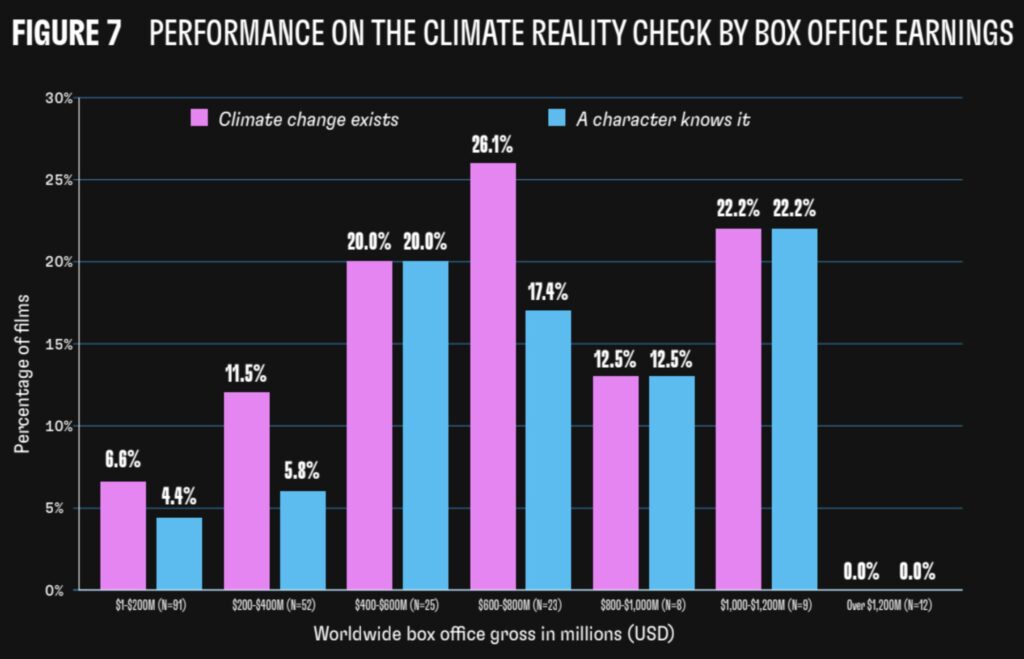
“Previous research by the Media Impact Project at USC found that many viewers [48% of respondents] want to see more climate change onscreen, and it’s well known that audiences like to see their reality reflected in their entertainment,” he explains. “As the climate crisis has become more obvious and more people are alarmed about it, it makes sense that films that include climate change would attract viewers and be profitable.”
Meanwhile, streaming services performed much better on the Climate Reality Check than other studios, with 16.7% of films on Netflix, Amazon Prime and Apple TV+ passing the test (and a quarter passing the first part), albeit with a smaller sample size of 30. Likewise, movies that went straight to streaming were nearly twice as likely to include climate change in their stories (with 20% meeting the first criteria, versus 11.8% of theatrical releases), and more likely to have climate-aware characters too (13.3% versus 9.1%).
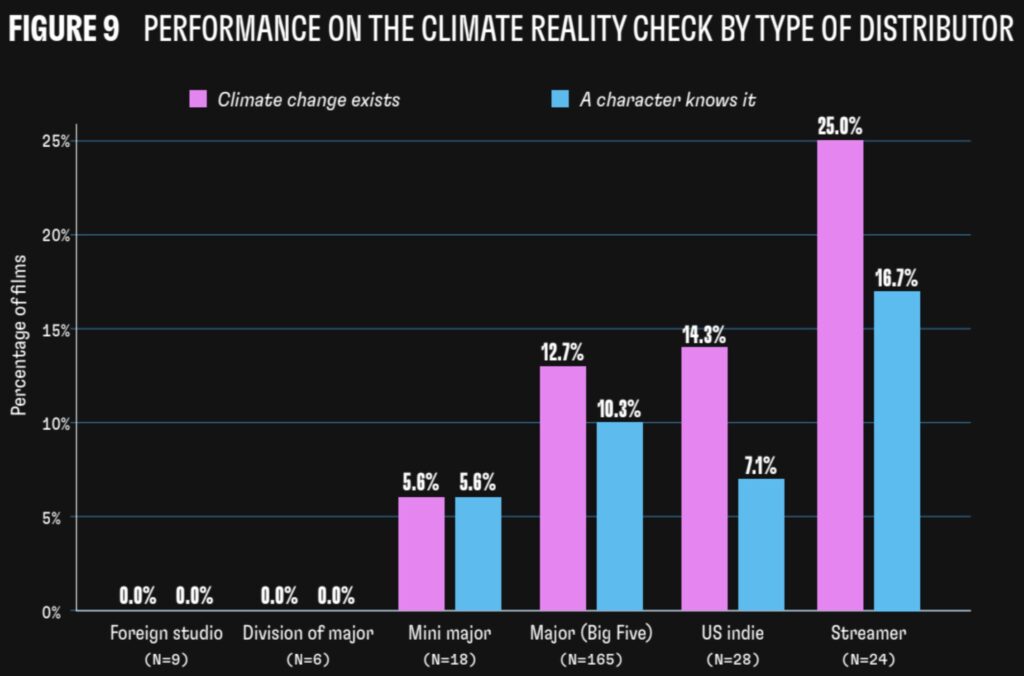
“One major difference between these groups of distributors is that the streamers have a wealth of proprietary data about what viewers are looking for in their entertainment,” explains Schneider-Mayerson. “It’s possible that their data is telling them what the results of our research highlight: that including climate change in films is a win for both studios and the planet.”
Climate-aware characters misrepresent reality
The research suggested that there was a gap in the demographic representation of characters aware of climate change in the movies analysed. Characters that enabled films to pass the second part of the test were overwhelmingly male (69.5%), white (65%), and middle-aged (77.1%), despite studies showing women, younger people and Black, Indigenous and minority groups are more likely to talk about, be alarmed by and bear the brunt of climate change than men.
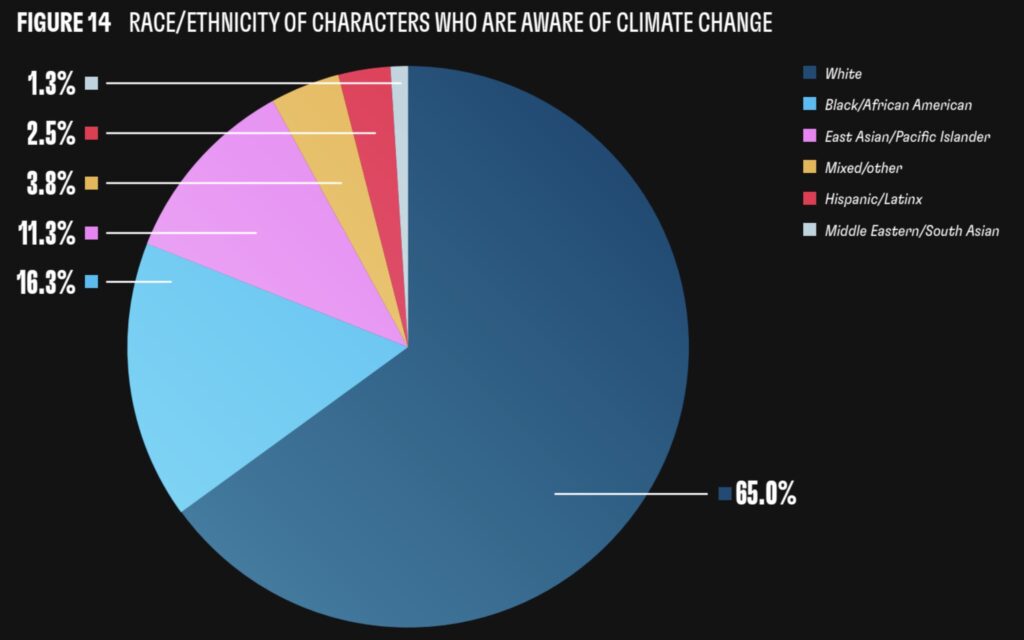
Similarly, a large-scale survey in 2022 revealed that 59% of people aged 16-25 are very or extremely worried about climate change, and 45% said it affected their daily life and functioning. But movies aren’t representative of this, with only 2% of films having at least one character experiencing climate anxiety.
It’s far from reality – as are superhero movies, which actually tend to be more climate-conscious than other films. Of the 46 superhero films on the list, 17% passed the first part of the test (compared to 11.8% of the rest), and 14.9% fit both criteria (versus 8.4%). DC has the edge over Marvel here, with 30.8% of its films passing the Climate Reality Check, in contrast with only 8.3% of the latter – these include Justice League, Aquaman, Eternals and The Batman.
Perhaps unsurprisingly, sci-fi movies lead the way in terms of climate representation, with 16.7% of films in this genre passing the Climate Reality Check. This was followed by adventure (15.9%), mystery (12.5%) and action (11.4%) stories. No movies in the sport, animation, biography, romance or crime genres passed the test, though the latter two had some films meet the first criterion (5% and 7%, respectively).
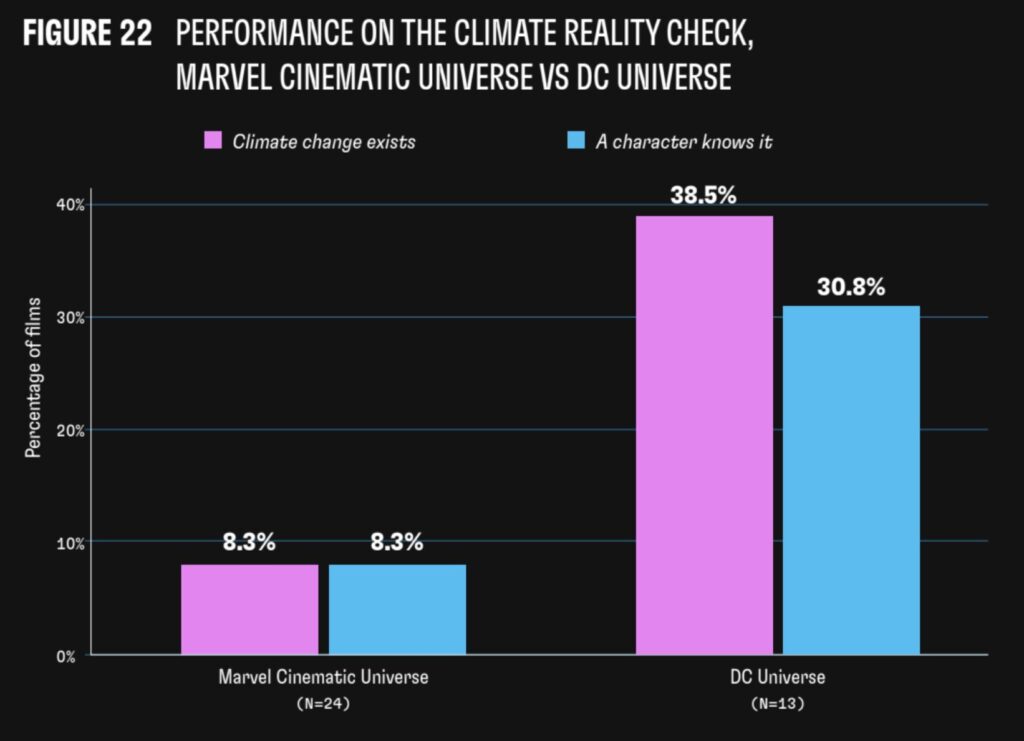
“Most films that passed the Climate Reality Check were in the superhero, sci-fi, and adventure genres, perhaps because these genres tend to operate on epic, global scales, in which existential threats abound,” says Schneider-Mayerson. “But climate change isn’t just a story about the end of the world – it’s affecting the places we live and the people we love. The climate crisis can be creatively and authentically incorporated into films of any genre, and there are a growing number of films that demonstrate remarkable creativity in doing so.”
There appears to be a shift in the kinds of storytelling from the first half of the decade to the second – the former saw movies portray climate change as a giant threat we need superheroes to save us from, while the latter involved more domestic storylines about everyday people experiencing or mentioning the climate crisis.
The role of the Big Five studios
The authors outline that ultimately, climate change representation is dependent on the actions of North America’s Big Five film studios – Warner Bros. Paramount Pictures, Sony Pictures, Walt Disney Studios, and Universal Pictures – which account for 80–85% of US box office revenue. Even in the sample of films analysed for the report, these distributors were responsible for 70% of the films and represented 90% of the box office gross.
Each of these studios has publicly committed to incorporating more climate-conscious themes in stories, which the report identifies as a hopeful sign. But the film industry still has some way to go to meet Good Energy’s 2027 goal. To get there, the authors recommend clearer and a greater number of mentions of climate change onscreen when possible, as passing mentions may get lost.
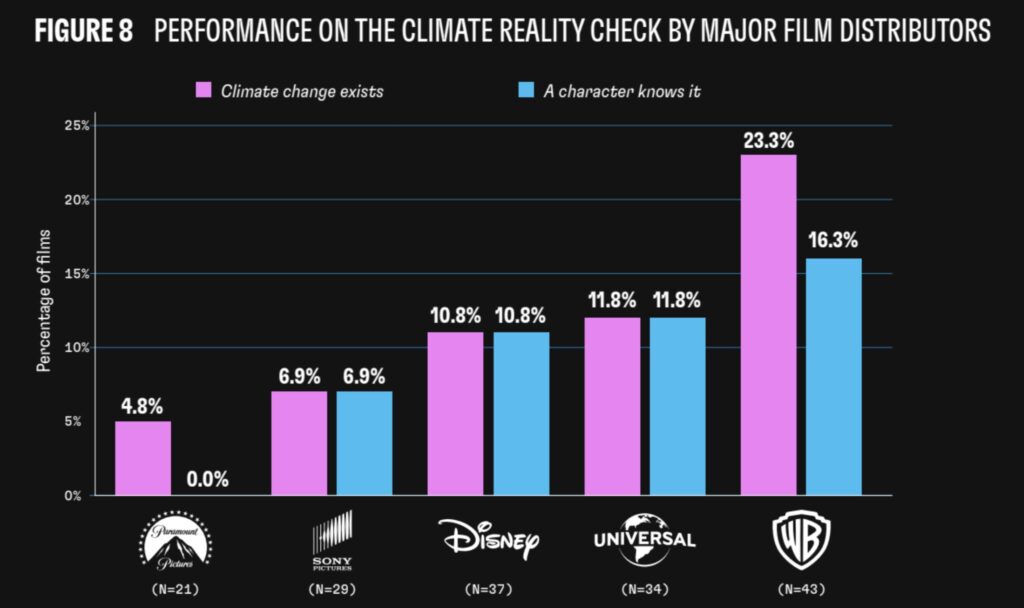
They also call for more genres to weave climate change into their storytelling. They argue that Americans underestimate how concerned people are about the crisis, which contributes to a “spiral of silence” around the subject. So movies should include more characters who are aware of, talk about or take action on climate change, which normalises and models conversations about the subject for everyday audiences.
Since most of the characters representing an awareness of climate change are male, white and middle-aged, there needs to be a shift to showcase the reality of the demographics most brutally affected by the crisis. Finally, modelling positive climate behaviours through characters who use bicycles or public transport, eat less meat, and utilise renewable energy can make an impact regardless of whether climate change is included in a story. Studios like Netflix have recognised this, with the streamer recently announcing that it would feature more electric vehicles.
“Climate change is the biggest story of our time,” the authors write. “It’s also an incredibly exciting story, replete with drama, comedy, tragedy, horror, adventure, love, conflict, real-life villains, massive stakes, and a million potential heroes from all walks of life. Storytellers can help us face and respond to the existential crisis that is unfolding around us – and in doing so, they might just help save the world.”



